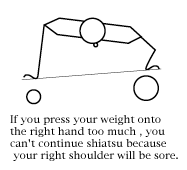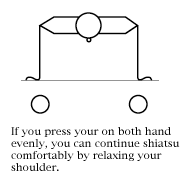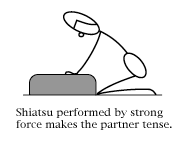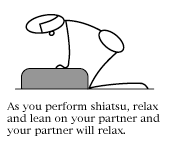Check Your Shiatsu Form Again (Nobuyuki Fujisaki & Masami Fujisaki)
It is very important for us to keep the three principles of shiatsu in mind when performing shiatsu precisely. Stationery pressure is the most important principle for bringing out the effect of shiatsu. I discuss the importance of this in my seminar and teach it to participants. Stationery pressure is a simple action that lasts for several seconds. However, few practitioners continue to perform it correctly. At first they perform stationery pressure accurately, but after a while, it becomes shorter and shorter, and finally the movement becomes rhythmic like massage. They don’t change the rhythm deliberately, but the movement becomes fast unconsciously. We must repeat simple movements many times in shiatsu. Accordingly, it is easy for us to become tired of such simple movements and for the motion to become faster and faster, even if we understand the importance of stationery pressure.

Shiatsu practitioners who perform stationery pressure correctly do it slowly. It looks like a slow-motion movie, and they cannot press many points in an hour. This affects not only the quantity of pressure, but also the quality in shiatsu. The three principles of shiatsu shows power balance at the pressure point, but it is difficult to explain the pressure of shiatsu because this principle refers to physical quantity, not to quality. When you perform shiatsu on a healthy person, you don’t have to consider “quality” much.
However, you do have to consider “quality” if the patient is sick. The “quality” of shiatsu pressure is “touch”, which is the feeling that a person feels when he or she has pressure applied to them. In other words, it means whether they feel comfortable or uncomfortable. It does not mean the force of the pressure. Comfortable pressure is pressure given from a relaxed practitioner. A patient also feels that this pressure is comfortable even if it is strong.
On the other hand, uncomfortable pressure is given when a practitioner is tense, and then the patient feels uncomfortable. The practitioner strains himself by using uncomfortable pressure, and the patient also strains himself by receiving it. In other words, the patient is tense if the practitioner is tense. The patient unconsciously strains muscles from the uncomfortable pressure, and the skin prevents the pressure from healing, but the patient becomes tenser as the practitioner tries to press the skin more strongly. Beginners often perform this mistake. The problem is that the patient strains their muscles, and the tsubo prevents pressure. Even if the practitioner tries Kyo-Jitsu, the tenseness of the patient prevents shiatsu pressure from advancing. The finger cannot go into the meridian if it is on it.

Pressing which is performed while relaxed can make the patient relax and the pressure penetrates the body deeply. The practice of shiatsu is similar to sports training. For example, you cannot drive a ball very far in golf if you hit it while you’re tense. If you have a correct and relaxed form, you can drive the ball far. Shiatsu is the same as golf. If you want to perform shiatsu effectively, you have to get the correct form of shiatsu first. You may still perform shiatsu if you understand meridians or Kampo, but it won’t be correct unless you apply the right kind of pressure.
What form of shiatsu is good?
Shiatsu will not be effective, even if you concentrate on your fingertips and press the tsubo, if you use incorrect pressure.You must lean on the person to give them correct pressure, relaxed pressure, in order to be effective. First, you must learn the basic form of shiatsu. Developing the correct form is the most important part, and then it must be practiced until the pressure is recreated correctly every time, even in clinical practice. The goal is to learn the patterns of total body treatment. The difference between acupuncture and shiatsu is manipulation. Shiatsu is performed on the whole body, whereas acupuncture is performed only on the fingertips in Japan. Therefore, it is easy for us to understand shiatsu as an analogy to a sport rather than as a medical skill.
The basic form of shiatsu pressure
First let’s review the basic pressing form. Pair yourself with another person, and ask your partner to lie facedown.

Sit beside him as close as possible. Next, put both your hands on his back. You must not square your elbows; just bend your elbows a little. You are now in the position for shiatsu. Next lift your body slowly up and move yourself into the right place for Shiatsu. Use your hands mainly with your shoulders raised. Don’t bend your elbows when you press or you will grow tired,which will cause tense pressure instead of stationary pressure. Move your shoulders above your partner and press down. Don’t push your partner horizontally. The stop of the movement follows the principal of vertical pressure.
As the vertical direction is of gravity in this case, the direction of pressure is vertical, once your weight repose on your hands put on the back.Then you may stop the motion at this moment.When the motion stops before being vertical, it is feeble and inadequate pressure. When the motion stops after being vertical, it is tense and uncomfortable pressure.When the pressure stops in the vertical position, the patient feels comfortable.This is relaxed pressure. Another person may watch your motion to judge if it is vertical or not. You may have the timing checked, as it is the pressure when your arms becomes vertical to the floor. When it is vertical, you must not push the back of the patient. You don’t have to press the back with elbows squared. You may bend them just a little. If you push the back at this time, it changes from relaxed pressure to tense pressure. Return to the starting position slowly after doing the stationery pressure. We learn the three principles of shiatsu and the touch of the pressure through this basic movement.
The skill of the pressure and oriental medicine

Today there are lots of practitioners who perform shiatsu forcibly like massage, but this way decreases your physical strength and is especially hard for women or weak people to continue shiatsu.It is very important not to push, but lean on the patient. Practitioners who lean on patients makes them comfortable, and the practitioner won’t injure their fingers. Therefore, people who perform forcibly must change their style. In addition, this style is the basic skill for learning shiatsu diagnosis, which we will learn before long. We must know it as the oriental medical skill as well as the physical way for the pressing.
———————————————————————–
© Nobuyuki Fujisaki & Masami Fujisaki (Zen Shiatsu Association)
Nobuyuki Fujisaki is born in 1954 in Tokyo, Japan and Graduate Tokyo Electrical Engineering College after majoring in Tele Communications. He became interested in Shiatsu Therapy at age of 11 and began practiced own method of Shiatsu until the age of 20 , when he joined the Ioh Kai Zen Shiatsu Center, where he studied original style of Zen Shiatsu under the Master Shizuto Masunaga. After graduating from the Institute, he went to the Japan Shiatsu School in Tokyo and obtained a National License for Shiatsu Therapy in Japan in 1987. After obtaining a license, he formed the “Zen Shiatsu Association” to promote this unique method of Shiatsu treatment world-widely. His activities include teaching, seminars, workshops teaching classes for professional Shiatsu therapists.
Masami Fujisaki is born in 1959 in Chiba, Japan. Graduated from Kanda Institute of Foreign Languages. After 2 years of studying psychology in Crafton Hills College, California, Masami graduated from the Japan Shiatsu School. At the same time, she studied Zen Shiatsu in the IOHKAI Shiatsu Center and got a certificate from the institute. She obtained Japanese national license of a professional therapist of western massage, Chinese massage, and Shiatsu therapy in 1987 and started to manage Zen Shiatsu Association with her husband to promote Zen Shiatsu therapy. She is a Zen Shiatsu therapist and instructor.
